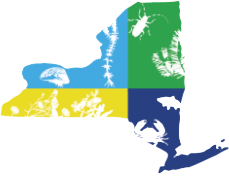By: Abby Bezrutczyk
Collaborating with a new generation of ecologists, Dr. Tim McCay is researching Asian Jumping Worms– an invasive species that’s spreading right under our noses. We welcome his responses for this NYISRI researcher spotlight:

What kinds of research questions related to invasive species are you currently asking?
Students and I pursue questions related to invasive earthworms, particularly Asian jumping worms. We would like to know what effect they are having on other animals, like ground beetles and litter spiders, that live alongside earthworms at the forest floor. The forest floor, including soil, leaf litter, and woody debris, is a very diverse ecological system. Unfortunately, the critters that live there do not get a lot of attention. We are also interested to know how jumping worms differ behaviorally, physiologically, and ecologically from the invasive earthworms from Europe (like the nightcrawler). We would like to better understand how they spread across the landscape. To what extent can they spread on their own and how dependent are they on people for moving them around? Finally, we have started experimenting with different ways to control them in the garden setting.
What are the basic methods you are using to answer your research questions?
We use a combination of field and laboratory studies to better understand these animals. There is no substitute for long-term detailed observations of animals in different situations. This sort of natural history work is especially important with animals that we do not know a lot about, like jumping worms. On the other end of the technological spectrum, we use computer simulation models of jumping worm populations and compare them to what the worms seem to be doing in forests of central New York. When the models match reality, we know that we have built them on accurate assumptions about how jumping worms grow and spread, and this teaches us something about how these unwanted populations become a problem.
Do you have a personal story or path that led to your interest in this research?
In 2004 my family moved into a new house in Madison County and found the property infested with bizarre, excitable earthworms that I did not recognize. I soon learned that they were Asian jumping worms, which were unknown from Upstate New York at that time. I found it striking – and still do – that like many invasive species, jumping worms are spreading quietly– right under our noses.
How does your research relate to the wider field of invasive species prevention/management?
Jumping worms are spreading rapidly across North America. By better understanding the processes that are important to their spread, we may be able to recommend policies to slow them down. If we are able to find control measures that can dampen populations without affecting desired plants and other animals in gardens, this might reduce the rate of spread into adjacent woodlands.
What do you hope the long-term impact of your work will be?
I want to contribute to our understanding of these obnoxious and fascinating creatures. By learning more about them, we can better resist, control, and live with them. As a professor at a small college, where teaching is important, perhaps the greatest long-term impact of my work will be in motivating students to be good ecological citizens. All of my research projects are collaborations with undergraduate students. A few of these student collaborators have gone on to research careers focusing on invasive species, which has been very satisfying.

